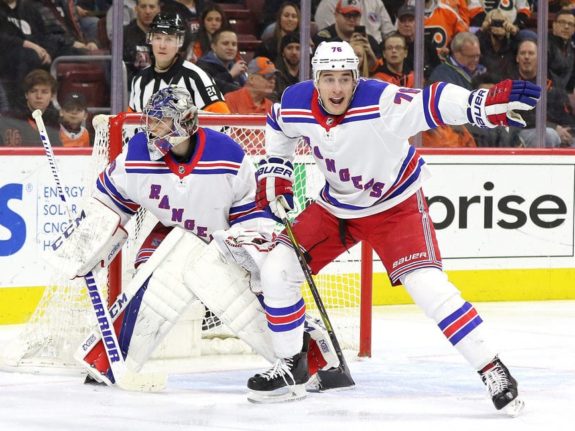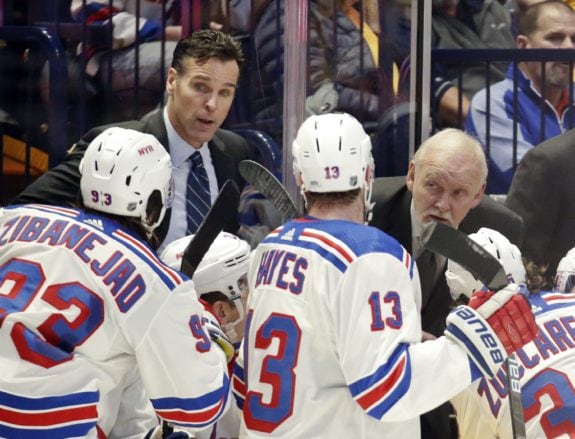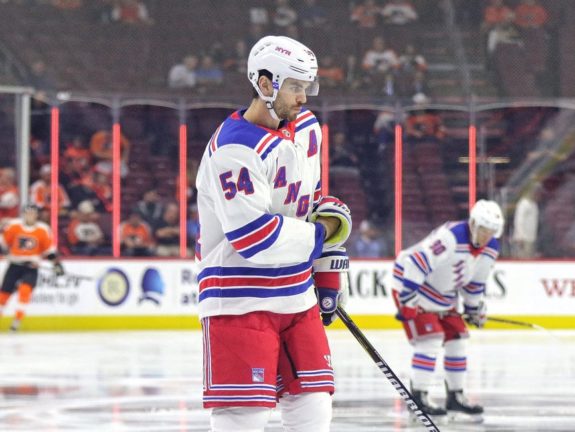![]()
The New York Rangers are committed to doing everything possible to help young defenseman Brady Skjei regain his 2016-17 NHL All-Rookie Team form. The solution, however, can truly come from only one place – between Skjei’s ears.
Head coach David Quinn has applied his tough love/supportive and nurturing approach. The club has tried multiple partners on the backline, and to that end might even need to consider re-signing a veteran who seemed certain to be headed out of town before the trade deadline. There have been several benchings, delivered under the pretense of opportunities to let the fourth-year player catch his breath, watch and learn.
The Rangers still see the 24-year-old Minnesotan as he was three years ago – the potentially prototypical modern NHL defenseman, boasting size (6-foot-3, 214 pounds) and uncommon skating ability for a big man, along with an offensive dimension to his game as well as the acumen to defend using strength in addition to positioning and stick skills.
If that seems like a lot for the Rangers to expect, it’s because Skjei showed them all of that in 2016-17, when in his second season, he recorded five goals, 34 assists and a plus-11 rating in 80 games and gave his club every indication that it had a top-pair blue line anchor in the making.

The problem is that the Skjei of that season hasn’t reappeared since. He stunned team management last season with a significant regression, finishing with four goals, 21 assists and a ghastly minus-27 rating over 82 games in an effort marked by poor decisions and a seeming lack of fundamentals in his own end.
That wasn’t enough for the Rangers to stop betting on Skjei, however. The often-ugly final season of Alain Vigneault left plenty of players with hard-to-look-at stats, and the front office chose to view Skjei’s rough effort as an anomaly, brought on in part by team-wide ineptitude and a disconnect with a coach on his way out the door at season’s end. General manager Jeff Gorton inked Skjei to a six-year, $31.5 million contract – with a $5.25 million annual cap-hit – with the full expectation that the best of Skjei was yet to come.
McQuaid the Key to a Skjei Resurgence?
That might well prove to be the case, but if so, that version of the player is taking his time to return. Skjei hasn’t been discernibly better this season, with three goals, 10 assists and a minus-seven rating. The bad decisions with the puck still occur, even if they’re somewhat less frequent. The overarching issue, however, is that Skjei’s impact on games has been greatly diminished from three years ago, the player seeming unsure of himself and lacking the youthful confidence of that first full season.
What appears abundantly clear is that the 28th overall pick in the 2012 draft is struggling to get out of his own way.
“This is a guy that we have a lot of faith in,” Quinn said after benching Skjei for the third time this season in a 4-3 shootout loss to the Winnipeg Jets on Dec. 2. “He’s a really good player having a little bit of a struggle. He’s going to get right back in there and we’re going to get this right. He’s going to be a big part of what we’ve got going on now and the future. It’s not a punishment, it’s more take a deep breath and let’s get back at it.”
A month and a half later, Quinn is still waiting for Skjei to reward that faith. He played a solid game in the Rangers’ 4-3 victory over the Chicago Blackhawks on Thursday, finishing plus-one in 22:03 of ice time that left him at even over the past nine games. Small steps matter for Skjei at this point.

Thursday’s effort came with veteran Adam McQuaid on his right, a pairing that returned to being a constant starting in late December. Though possession metrics don’t support the duo being a particularly effective one, Skjei is more comfortable and confident (there’s that keyword again) playing with the stay-at-home veteran than he was with the offensive-minded Tony DeAngelo, with whom he partnered for 17 of the 21 games McQuaid missed after getting injured in October.
“Adam and I have had good chemistry and I think we played well when we were together at the start of the year, ” Skjei said in December. “That’s not to say that Tony and I didn’t play well or couldn’t play well, but Adam brings a little different element to it. When I — or Tony — play with a more defensive-minded partner, there are fewer decisions to make about whether to go or stay back.
“Adam is one of the best defenders I’ve ever played with. He’s very steady and tough to play against.”
Does that change the Rangers’ plans for McQuaid, who was acquired from the Boston Bruins for fourth and seventh-round draft picks and defenseman Steven Kampfer in September? The priority for the rebuilding Blueshirts was to build up the 10-year veteran’s value enough to trade him to a contender at the deadline. Perhaps the pending unrestricted free agent’s real value to the Rangers is instead playing next to Skjei for the next few seasons.

Rather than deal him off next month, would the club consider inking McQuaid, who’s had trouble staying on the ice the last two seasons but has been a stabilizing influence when he’s played, to, say, a two-year contract? Hardly old at 32, McQuaid’s calming effect on Skjei, not to mention the toughness and leadership he brings to a young, uncertain roster, would seem to be of greater use than the third or fourth-round pick that might come back in a trade at this point.
Skjei Struggling to Harness All of his Gifts
That remains to be determined, but fixing the problem is, of course, bigger than whether the Rangers keep McQuaid for a few more years. There has to be more than a little concern at this point that the front office overestimated Skjei’s ceiling when it made what it believed was a proactive move in inking him to a long-term contract. That’s made getting Skjei on track considerably more important, given that the financial commitment has left the Blueshirts with few other options.
The club’s vision was of Skjei anchoring the defense into the next decade, taking the mantle from the departed Ryan McDonagh – and perhaps even ascending to the captaincy once held by the beloved “Mac.” Skjei’s extension makes him the only Ranger signed past 2021-22.
Now, though, the fear has to exist to at least some degree that all of Skjei’s tools make him a jack of all trades but a master of none – a supremely talented guy who just isn’t able to put it all together to full effect. Sports history is littered with such players.
It’s probably too early to seriously consider that type of outcome for Skjei, but despite all of his gifts, something still seems lacking. Perhaps it is an element of physical edge and nastiness – a major complaint of Quinn’s about his roster – as Skjei’s manner on the ice seems to lean toward more that of a pure skill player than the bruising force that he could be when necessary. For that, he should be able to draw inspiration from the feared McQuaid as well as Marc Staal, who isn’t an overly physical defender but whose nasty streak seems to emerge when he needs it.

While the worrisome possibility certainly exists that Skjei will turn out to be too much Wade Redden and not enough Chris Pronger, it’s probably more likely that this 20-something is in the process of figuring out what kind of player he is and subsequently, who he wants to be – not unlike any other 20-something. Quinn and the front office will continue to support him and help him through this difficult time that’s into its second season, while doing their best to keep any long-term doubts to themselves.
“Part of my problem has been trying to do too much,” Skjei said. “And my play is my responsibility, not my partners’. I’ve talked about it before, but there were times I put too much pressure on myself. I need to keep it simple and solid and be decisive. I feel that my game has been coming back, but it has to be on a much more consistent basis.”
Team management is hoping that his confidence follows. After all, the Rangers aren’t about to give up on the potential of a player who showed such tantalizing glimpses of what he could become not long ago. With five more years to go on Skjei’s contract after this one, it’s not as if they have much of a choice.